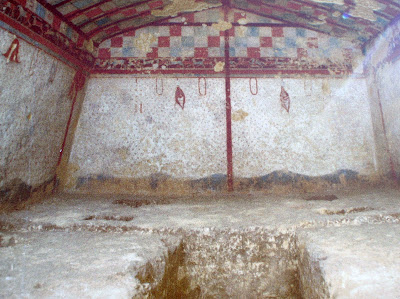The Necropolis of Monterozzi was a spur of the moment decision to tour. We had seen all of the routine tours of Rome so we thought it was to be a leisure day. But Christine spotted a tour that sounded interesting, and I think she picked it because I couldn't pronounce any of the words. So I had to do some homework. (Editor's note: I'd grown up reading Nat'l. Geographic Magazines and had taken a college course on Etruscan history. Attaining a dream was thrilling to me even if it meant more broken rocks to Roy.)
Necropolis means a cemetery, especially a large and elaborate one belonging to an ancient city.
Monterozzi means a hill or hump.
That meant we were going to tour an ancient cemetery on a hill. Oh boy!
Right inside the entrance, we saw a bunch of mushroom-looking stones. The guide quickly pointed out that they were urns to hold the ashes of the citizens who weren't very wealthy.
The wealthy built underground tombs that looked like a hump (Monterozzi?) on the surface.
Six thousand of these tombs have been discovered, but only 15-20 are open to the public at one time. Christine tried to see all 6,000 but fortunately, we ran out of time. The tombs are entered through a hut looking structure with stairs leading down to the tomb. To protect the tombs, a glass barrier is at the bottom of the stairs. Taking pictures through the barrier makes the pictures look funny.
Tomba Delle Leonesse
The ceiling had a checkerboard motif and the walls were divided by six columns that gave the tomb the appearance of a pavilion. On the gable of the end wall were depicted two she-lions face to face.
In the center of the wall is a great crater with whirls flanked by two musicians; on the left there is a female dancer, opposite her was a couple dancing. Along the side walls were banqueting diners reclining.
The decorative concept of this tomb is that of a tent, normally used for the deposition of the corpse, but here intended as a hunting pavilion. Note the two ducks hanging by the beaks on the end wall.
Fowling and Fishing Tomb
The gable depicts a banquet. The wall has scenes of hunting and fishing, brightly colored rocks from which some hunters shoot at birds with bows and slings.
Same tomb without the zoom.
Tomba Dei Caronti
The false door symbolizes the entrance to the nether-world and is guarded by the Etruscan demon of death.
Tomb 5636
Not yet identified with a specific family, the fresco is a scene related to the dead buried in the grave below the picture. They are preceded by a child followed by a Vanth-Etruscan female demon with a torch to light up the dark way to the afterlife-dead. (A Vanth is a female demon in the Etruscan underworld but is a benevolent guide, not an avenging spirit). They are met by two members of the family already dead. Coronte is seated on a rock as a keeper-dead at Hades' (underworld) door.
The following tombs were not identified in my notes but they are still pretty (as tombs go).
Not yet identified with a specific family, the fresco is a scene related to the dead buried in the grave below the picture. They are preceded by a child followed by a Vanth-Etruscan female demon with a torch to light up the dark way to the afterlife-dead. (A Vanth is a female demon in the Etruscan underworld but is a benevolent guide, not an avenging spirit). They are met by two members of the family already dead. Coronte is seated on a rock as a keeper-dead at Hades' (underworld) door.
The following tombs were not identified in my notes but they are still pretty (as tombs go).
Note: This was not the end of our tour, just the end of the Necropolis portion.
















































.JPG)











.JPG)













